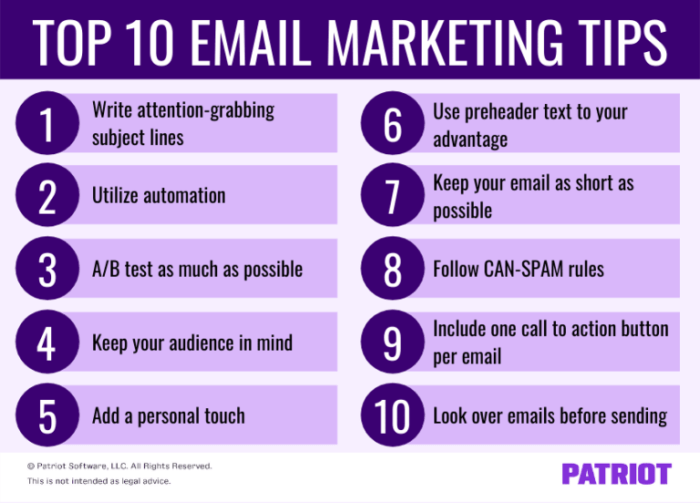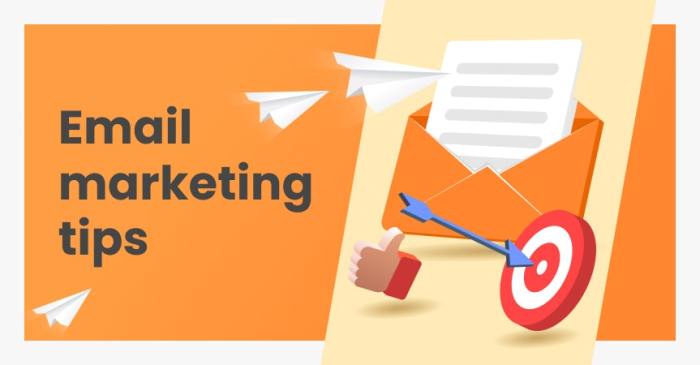Email Marketing Tips: Get ready to take your email campaigns to the next level with these expert strategies that will boost engagement and drive results. From building your email list to crafting compelling content, this guide has you covered.
Introduction to Email Marketing Tips
Email marketing is a powerful tool used by businesses to communicate with their audience through email. It involves sending promotional messages, newsletters, updates, and more to a list of subscribers.
Importance of Email Marketing
- Email marketing is essential for businesses to build and maintain relationships with customers.
- It helps businesses drive sales, increase brand awareness, and promote products or services.
- With email marketing, businesses can reach a targeted audience directly in their inbox.
Statistics on the Effectiveness of Email Marketing
“Email marketing has an average ROI of $42 for every $1 spent.” – DMA
“80% of retail professionals indicate that email marketing is their greatest driver of customer retention.” – Emarsys
“91% of consumers check their email daily.” – HubSpot
Building an Email List

Building an email list is a crucial aspect of email marketing. It involves growing your subscribers organically, segmenting your list effectively, and creating engaging opt-in forms on your website.
Strategies for Growing an Email List Organically
- Offer valuable content: Provide your audience with relevant and valuable content that they will find useful and engaging.
- Use social media: Promote your email list on social media platforms to reach a wider audience and attract new subscribers.
- Host webinars or events: Organize webinars or events related to your industry to attract potential subscribers who are interested in your content.
The Importance of Segmentation in Email Lists
- Targeted messaging: Segmentation allows you to send personalized and targeted emails to different segments of your audience based on their interests or behavior.
- Higher engagement: By sending relevant content to specific segments, you can increase engagement rates and ultimately drive more conversions.
- Improved deliverability: Segmented lists can lead to better inbox placement and lower spam rates, as you are sending content that is tailored to each subscriber.
Tips for Creating Engaging Opt-In Forms on Websites
- Keep it simple: Make your opt-in forms easy to fill out with minimal fields to reduce friction and increase sign-ups.
- Offer an incentive: Provide a compelling reason for visitors to subscribe, such as a discount, exclusive content, or a free download.
- Use eye-catching design: Make your opt-in forms visually appealing with clear call-to-action buttons and attractive visuals to grab the attention of visitors.
Crafting Compelling Email Content
Crafting compelling email content is crucial for engaging your audience and driving action. From subject lines to the actual email copy, every element plays a vital role in capturing the reader’s attention and encouraging them to take the desired action.
Effective Subject Lines
Subject lines are the first thing your recipients see, so they need to be attention-grabbing and enticing. Here are some examples of effective subject lines:
- “Don’t Miss Out: Exclusive Offer Inside!”
- “Limited Time Only: Shop Our New Collection Now!”
- “Unlock Your Savings: Open Now for a Special Discount!”
Tips for Writing Engaging Email Copy
When it comes to writing engaging email copy, keep these tips in mind:
- Keep it concise and to the point.
- Use a conversational tone to connect with your audience.
- Incorporate storytelling to make your emails more compelling.
- Include a clear call to action that prompts the reader to take the next step.
The Importance of Personalization in Email Content
Personalization is key to making your email content resonate with your audience. By addressing recipients by their first name, tailoring content based on their preferences, and segmenting your email list, you can create a more personalized experience that drives engagement and conversions.
Designing Emails for Maximum Impact
In today’s digital age, where most people access their emails on mobile devices, it is crucial to design your emails with mobile-responsiveness in mind. Creating visually appealing emails with the right balance of text and images can significantly increase engagement and conversion rates. Let’s dive into some tips for designing emails that leave a lasting impact on your audience.
Importance of Mobile-Responsive Email Design
When designing emails, always consider how they will appear on mobile devices. Mobile-responsive design ensures that your emails are easily readable and visually pleasing on smartphones and tablets. This is essential as a large portion of email opens happen on mobile devices. By optimizing your emails for mobile, you can reach a wider audience and deliver a better user experience.
Tips for Creating Visually Appealing Emails
- Use a clean and minimalistic layout to avoid clutter and confusion.
- Choose a visually appealing color scheme that aligns with your brand.
- Incorporate eye-catching graphics and images to captivate your audience’s attention.
- Keep your email content concise and to the point, focusing on the most important information.
- Include clear call-to-action buttons that stand out and encourage recipients to take action.
Role of Images and Multimedia in Email Marketing
Images and multimedia play a vital role in enhancing the visual appeal of your emails and conveying your message effectively. They can help break up text, highlight key points, and evoke emotions in your audience. However, it’s essential to use images strategically and ensure they are optimized for fast loading times. Including videos, GIFs, or interactive elements can also make your emails more engaging and memorable for recipients.
Email Automation and Personalization: Email Marketing Tips
Email automation and personalization are key elements in successful email marketing campaigns. By utilizing automation tools, businesses can send timely and relevant emails to their subscribers without the need for manual intervention. Personalization, on the other hand, allows for a more tailored approach, increasing engagement and ultimately driving conversions.
Benefits of Email Automation, Email Marketing Tips
- Save time and resources by automating repetitive tasks
- Send targeted messages based on user behavior and preferences
- Improve lead nurturing and customer retention
Personalizing Email Campaigns
- Segment your email list based on demographics, behavior, or interests
- Use merge tags to address subscribers by their name
- Send personalized product recommendations or content based on past interactions
Examples of Successful Automated Email Campaigns
- Abandoned cart emails that remind customers of items left in their cart
- Post-purchase follow-up emails requesting feedback or offering related products
- Personalized birthday or anniversary emails with special offers or discounts
Analyzing Email Marketing Performance

When it comes to email marketing, analyzing performance is key to understanding what works and what doesn’t. By tracking key metrics, analyzing data, and A/B testing campaigns, you can improve your email marketing strategy and drive better results.
Key Metrics to Track
- Open Rate: This measures how many recipients opened your email. A high open rate indicates that your subject line and sender name are effective.
- Click-Through Rate (CTR): The CTR shows how many recipients clicked on links within your email. It indicates the engagement level of your content.
- Conversion Rate: This metric tracks how many recipients completed a desired action, such as making a purchase or signing up for a webinar, after clicking on a link in your email.
- Bounce Rate: Bounces occur when emails are not delivered to recipients’ inboxes. High bounce rates can negatively impact your sender reputation.
Analyzing Email Marketing Data
- Segment Your Audience: Analyze data based on different segments of your email list to understand how different groups of subscribers engage with your emails.
- Track Trends Over Time: Look for patterns in your email performance data over time to identify what strategies are working and what needs improvement.
- Use A/B Testing: Test different elements of your email campaigns, such as subject lines, content, and calls to action, to see which variations perform better with your audience.
Tips for A/B Testing Email Campaigns
- Test One Variable at a Time: To accurately determine the impact of changes, only test one element at a time, such as subject line or email design.
- Set Clear Goals: Define specific goals for your A/B tests, such as increasing open rates or click-through rates, to measure the success of each variation.
- Analyze Results Statistically: Use statistical significance to determine if the differences in performance between variations are meaningful or just due to chance.












